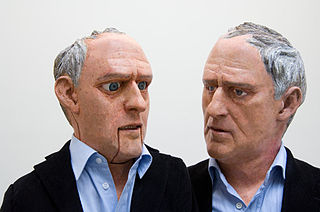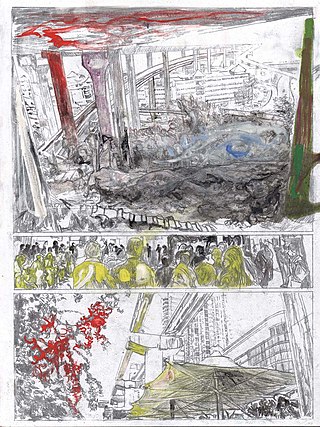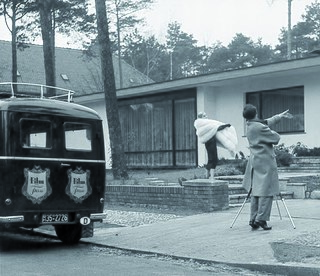Career
Her work includes installations, sculptures, textiles and fashion objects which consistently reference art, fashion and design of the 20th century. [2] In combining traditional handicrafts such as fashion and textiles with masculine-dominated ones such as fine arts and object design, Siem questions the role of the creator by insisting on the role of the woman not just as maker but also as author. Her works, often sewed or carved, are intensively labour-based and often deal with themes of domesticity and the elaborate function which women perform in the social sphere. [3]
The majority of Siem's early work made use of the preceding German artistic generation as source material by consistently quoting and borrowing aesthetic elements albeit in a satirizing and ironic manner. [4] Over the course of her career, Siem has also drawn from a wide variety of ethnographic sources including puppets, traditional furniture design, and European folk costumes as well as elements of anthropology and sociology The artist lives and works in Berlin.
Work
Siem developed her first artworks in the form of dresses, murals and hats during and after her studies in Hamburg between 1983 and 1988. In these works, Siem makes use of 'traditional' female domains such as sewing and fashion to satirize and critically evaluate the influences of the influential artistic generation which preceded her. For example, her 'clothes-works' of the early 1980s are an answer to the textile works of the German artist Franz Erhard Walther by means of the designation "objects for use", a term which Walther himself used in describing some of his wearable fabric sculptures. Using eye-catching patterns partly offset on the surface of the dress, as if the parts had been carelessly sewn together, Siem creates a sense of formal alienation which visually lifts clothes designed for everyday use. Similarly, murals which were created by Siem in the same period reference the large-scale wall paintings by the German artist Blinky Palermo. Instead of composing a monochrome painting as Palermo would have done, Siem paints a marble imitation stone, as one would in a theater set. These wall works were placed in the public space such staircases, office halls, or cafés and remained there without being marked as a work of art, in some cases for years. Siem's 'hat works', on the other hand, are wearable objects which are not discernable as artworks apart from their uniqueness. In fact, Siem's textile works were only exhibited as art objects some years later, in the gallery Chantal Crousel in Paris in 1995. [7]
The Four Workgroups
From 1989 to 1997, Siem created four groups of works which occupy a central place in her oeuvre. The first group of works, created from 1989 to 1993, is composed of dresses, hats, bags, and shoes. As in her previous works, the artist's objects blur the line between art and fashion since it is both possible to wear them and consider them under objective aesthetic terms. As potential prototypes, they are normally exhibited in the style of a merchandise presentation one would find in a fashion store. [8]
The objects of the second group of works (1991-1994) are more ambivalent. The terms used to describe the objects - clothes, hairstyles, shawls, trolleys - suggests fashion or lifestyle objects, but the group of works itself resembles the collection of a cultural-historical museum. The 'clothes' are hard, like armor, and the 'hairstyles' (made of stone) are not actually possible to wear or even carry unassisted. The 'trolleys' are heavy wooden models similar to ones that might be found in an agricultural museum. The 'shawls' are thick tapestries made of felt. Hence the understanding of the female role is subverted and rehashed in the form of 'superficial' feminine objects ever which present themselves as increasingly absurd. [9]
Similarly, the third group of works (1993-1997) is also reminiscent of a museum collection. Untitled (6 Masks) is made up of six large furry outfits resembling traditional costumes of folk characters from the Alpine regions of Germany, Switzerland, and Austria. In the group Untitled (7 Masks) the artist has reproduced her own face in seven different facial expressions in reference to the 18th century German-Austrian sculptor Franz Xaver Messerschmidt. The group Untitled (42 Stones) ironically performs the formal canon of modernist sculptures in papier-mâché (visually referencing figures such as Hans Arp and Henry Moore) in 42 individual examples.
The fourth group of works (1995-1997) consists of an installation which creates the appearance of a huge room. A group of life-size dolls, figurines and wooden objects appear comically small, like toys, in the center of an oversize carpet. The dolls reference classical European doll forms as well as the sculptures and theater costumes of the Dadaist Oskar Schlemmer.
Rustic Furniture ("Bauernmöbel")
Wiebke Siem developed the series 'Rustic Furniture' during her first residency in the UK. All objects are 1:1 copies of existing German farm furniture of the 18th and 19th centuries in various private and public European collections. The objects create a sense of alienation due to the fact that the replica furniture has been painted brand new. They seem strange to the viewer, despite being lifted from a familiar cultural-historical background. This commentary on political and sociological framework raises the question of what can be considered strictly 'foreign' within the public sphere and what can be considered culturally one's own.
Costume Masks ("Maskenkostüme")
The mask costumes (2000/2001), mostly created during Siem's second stay in England, refer to objects of non-European cultures in preserved European museum collections, such as mask costumes of the African or the Pacific region. The carved masks, however, also make clear references to European modernism. (Modigliani, Schlemmer). Siem points out that the art of non-European space is a resource of European modernity.
The Counterfeiter ("Die Fälscherin")
Between 2005 and 2009, Siem worked on a group of larger installations that were shown in 2009 at the Neues Museum Nürnberg under the exhibition title Die Fälscherin. [10] In pre-and post-war room furnishings and furniture, large fabric sculptures are placed as actors in surreal domestic scenes. Anxiety, vision and comedy are central elements of the main installation, which consists of an "Africa collection" made up of household items obsessively occupying the entire room. [11]
Hot Skillet Mama
With the sculptures that have been created since 2010, Wiebke Siem freed her practice from the intricately crafted sculptures that have characterized her work for decades. She began to assemble her sculptures from simple household objects before working on them to give them a uniform surface. As disembodied sculptures they are not unlike skeletons and hang like puppets from the ceiling. [12] [13] As with many of Siem's works, the sculptures also express themes of alienation - the transformation of something familiar into something foreign. [14]
In the studio installation Der Traum der Dinge - The Dream of Things (at the K20 – Collection Nordrhein-Westfalen in Düsseldorf) Siem invited the visitors to assemble and hang household appliances into new figures, effectively creating new artwork out of common domestic tools by means of audience participation.
This page is based on this
Wikipedia article Text is available under the
CC BY-SA 4.0 license; additional terms may apply.
Images, videos and audio are available under their respective licenses.







